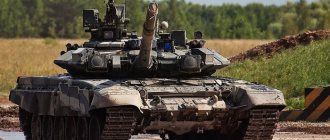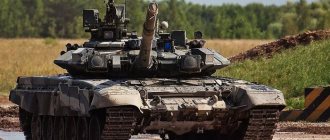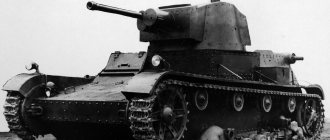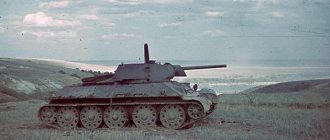The T-80 light tank was designed by the GAZ Design Bureau under the leadership of N.A. Astrov in the fall of 1942. At the beginning of November 1942, two experimental tanks were produced, which received the factory designation “0-80”. In December 1942, the T-80 tank was put into service. During serial production at plant No. 40 (Mytishchi) from April to September 1943, 77 T-80 tanks were manufactured. Since September 1943, the production of T-80 tanks was curtailed in favor of increasing the production of SU-76 self-propelled artillery mounts.
Description of the design of the T-80 tank
The general layout of the T-80 tank is identical to the T-70 tank. The tank's crew consisted of three people: the tank commander was in the turret to the right of the gun, the gunner was in the turret to the left of the gun, and the driver was in the bow of the hull on the left side.
The armor protection of the tank is bulletproof, consisting of rolled armor sheets with a thickness of 6, 10, 15, 25, 35 and 45 mm. The front and rear hull sheets and turret sheets had rational angles of inclination. In the upper frontal plate of the hull there was a driver's hatch, in the armored cover of which a rotating periscope viewing device was installed (on the first production vehicles, a viewing slot with triplex was made in the hatch cover). In addition, at the bottom right (along the direction of the tank) in the front plate there was a hatch for access to the transmission units, closed with an armored cover with bolts. In the lower frontal plate there was a hatch for the engine crank, which was closed with an armored cover.
A welded faceted turret of increased dimensions, made from armor plates 35 and 45 mm thick, was mounted on a ball bearing in the middle part of the hull with an offset to the left side and had a design for fastening the armored mantlet of the gun, providing large elevation angles for the armament. A fixed commander's cupola with an entrance hatch was installed on the roof of the tower. The tank commander's viewing device is installed on the rotating base of the hatch. The gunner's hatch is located to the left of the commander's cupola. In front of it on the left is a periscope viewing device, and on the right is a red dot sight hatch. Due to the installation of a new turret, the height of the tank increased by 135 mm.
Read: Vladimirov anti-aircraft installations
The tank's armament consisted of one 45-mm 20K model cannon. 1938 and a coaxial 7.62-mm DT machine gun (installed to the left of the gun). The tank's ammunition load was 94-100 rounds for the cannon and 1008 rounds (16 discs) for the machine gun. When shooting, the following sights were used: telescopic TMF-1 and collimator K-8T.
The power unit of the GAZ-203F tank consisted of two four-stroke six-cylinder GAZ-80 carburetor engines with a total power of 170 hp
The mechanical transmission consisted of a two-disc semi-centrifugal dry-friction main clutch: a four-speed simple automobile-type gearbox, providing four forward gears and one reverse gear; main gear with bevel gear: two multi-disc dry final clutches with band brakes: two simple single-row final drives.
The chassis of the tank, in relation to one side, consisted of one drive wheel of a front pinion gear; five support rollers with rubber tires: three support rollers; one rear-mounted idler wheel, identical to the support rollers: fine-linked caterpillar with a 260 mm wide track. The suspension system used a reinforced individual torsion bar suspension and travel limiters for the fifth road wheel balancers. The role of travel limiters for the first and third road wheels was played by the support rollers.
The tank was equipped with a 12RT radio station and a TPU tank intercom.
You need to know how to use a tank!
With medium and even more so heavy tanks rapidly gaining armor thickness and an increase in the caliber of tank guns, with a rapid change in the range and penetration of anti-tank artillery, the T-70 in all modifications became outdated faster than it could be produced. And yet, at the front, he found his niche and fought quite successfully until the end of the war, and was removed from service only in 1946.
At the same time, in the second half of the Great Patriotic War, they tried not to use the “seventy” in oncoming tank battles, and even to accompany infantry because of its thin armor and weak gun, the vehicle was perceived as old-fashioned. But as a reconnaissance tank or a support tank for cavalry units, the T-70 coped with its tasks quite well.
A characteristic review of the T-70 by Lieutenant General Semyon Bogdanov, who already in September 1943 emphasized: the high losses of these machines are associated primarily with their illiterate use. At the same time, General Bogdanov compares favorably with other vehicles in that even inexperienced drivers can easily handle them, and evacuating and repairing these tanks in the field is much easier than the same T-34. And in terms of its reliability, the “seventy” differed favorably from the same “thirty-four” or KV, which the tankers themselves paid attention to more than once.
And yet, on the battlefield, especially in oncoming tank battles, the T-70 was catastrophically inferior to heavier, armored and well-armed opponents. So in October 1943, the tank was discontinued in favor of the release of the legendary SU-76 self-propelled gun for direct infantry support, designed on its basis. By the way, in self-propelled artillery regiments armed with these vehicles, the role of command tanks was most often played by T-70s, including for reasons of unification of spare parts.
Attempts to modernize the “seventy” and install a two-man turret on it led to the appearance of the T-80, the last mass-produced light tank of the Red Army during the Great Patriotic War. Self-propelled anti-aircraft guns armed with heavy machine guns and a 37-mm cannon were also developed on the basis of the T-70, but they were never put into service.
Modifications and vehicles based on the T-70
The only serial modification (besides the basic one) was the T-70M. It was equipped with tracks of increased width, but this also required the installation of other road wheels, torsion bars of larger diameter, and reinforced brakes. None of these components were interchangeable with the units of the base series tanks, and it was impossible to modify the previous vehicles to the T-70M standard.
The SU-76 self-propelled gun, built on an extended chassis of the “seventieth”, became widespread.
And not just wide - it became one of the most popular armored vehicles in the Red Army. It was armed with a three-inch ZiS-3 divisional cannon and was used mainly for direct fire support of infantry.
In 1942, on the basis of the “seventieth” they tried to make a self-propelled anti-aircraft gun. The roof of the turret was cut off, and instead of the 45 mm gun, a 37 mm Sh-37 automatic cannon was installed. Other attempts led to the appearance of experienced anti-aircraft guns with twin DShK machine guns.
In an attempt to improve the combat qualities of the T-70, they tried to rearm it with a more powerful gun of the same caliber, and replace the turret with a double one. This project ultimately resulted in the T-80 tank.
History of the T-70
When the T-60 was put into service, everyone understood that it was only a temporary measure - its armor was too thin to withstand enemy tanks. At first there were attempts to modify the T-60 by installing a new turret on it, but this experimental T-45 tank was not put into production due to insufficient engine power.
The new tank, called GAZ-70, was completed at the end of 1941. Its assembly proceeded very slowly, and the first prototype was completed in February 1942. At first, the tank did not cause much enthusiasm - the new tank was not much superior to the T-60 in terms of armor protection, and its combat power was reduced to a minimum due to the fact that one person had to combine the functions of loader, gunner and commander. Soon the shortcomings were eliminated, and the T-70's frontal armor was comparable to the T-34-76, which was a serious achievement. As a result, it was decided to put the tank into mass production.
Technical characteristics in comparison with analogues
In 1942, light tanks began to fall out of widespread use. The American Stuart was outdated, and they were actively looking for a replacement. The German Pz.II was transferred to training units. The newest American and British light tanks were specialized vehicles for airborne troops.
| TTX/Tank | T-70 | M5A1 | Pz.II Ausf.F |
| Weight, tons | 9,2 | 15,7 | 10 |
| Length, meters | 4,2 | 4,8 | 4,6 |
| Height, meters | 2 | 2,6 | 2 |
| Maximum speed, km/h | 42 | 58 | 40 |
| Armament | 45 mm cannon, 7.62 mm machine gun | 37 mm cannon, 3x7.62 mm machine gun | 20 mm automatic cannon, 7.92 mm machine gun |
| Booking | Up to 45 mm | Up to 64 mm | Up to 35 mm |
The American light tank, developed before the war, was superior to the T-70 in both size and weight. At the same time, its 37 mm gun was inferior to the Soviet “forty-five”, and its voracious engines “provided” a small power reserve. The German light tank had the advantage in terms of communications and surveillance, but could not boast of anything else.
It is worth noting that the more modern American M24 tank, whose production began in 1944, was almost twice as heavy as the T-70 and was equipped with a more powerful 75 mm caliber gun. That is, although it was considered “light”, it was actually a car of a slightly different class.
Modifications
The T-70 was produced in two modifications, which differed in the design of the chassis:
- T-70, a tank weighing 9.2 tons and carrying 90 rounds of ammunition, the original version of the infantry support tank;
- T-70M with widened tracks and road wheels and reinforced suspension torsion bars. It has a mass of 9.8 tons and a reduced ammunition load of 70 rounds.
Upgrading the T-70 to the T-70M was impossible due to incompatible structural components.
Experienced tanks
The T-70 became the basis for many development works, which explored strengthening the tank's armament and improving ergonomics.
- T-70 with Sh-37 cannon. It had unsatisfactory ergonomics of the fighting compartment, despite the expanded turret and the absence of a machine gun;
- T-70 with a more powerful VT-42 cannon of 45 mm caliber. The tank successfully passed the tests, but by that time the T-70 had been discontinued and it was decided to install the VT-42 cannon on the new T-80;
- T-70 with additional space in the turret for the loader. Work on this experimental model eventually led to the creation of the T-80 tank, but the T-70 was never equipped with a two-man turret;
- T-70-3, anti-aircraft tank. It had a converted turret with two DShK heavy machine guns. Together with the anti-aircraft T-90, it took part in tests, which it failed due to an unbalanced weapon mount;
- T-90 is an anti-aircraft tank based on the T-70M with DShK machine guns. It passed comparative tests with the T-70-3, but had a number of disadvantages. They needed to be eliminated, but they did not have time to do this - the requirements for the performance characteristics of such vehicles changed, and work on the T-90 was closed.
Application
The T-70 was actively used in many units and units of the Red Army along with other tanks, most often with the T-34. These tanks received their baptism of fire in the summer of 1942, in battles in the South-Western direction, and it was then that their vulnerability was revealed.
However, the T-70 also had advantages - for example, they were ideal for pursuing retreating enemies, and in 1943 this task became very urgent. In addition, the T-70 had a reliable chassis and power plant, which allowed it to fly longer distances than the T-34 could. The relative quietness of the machine was also a plus.
The T-70 performed best in the Battle of Kursk. Despite the fact that the "seventies" were hit quite easily, they had a much lower percentage of irretrievable losses compared to the better armored T-34s.
The effectiveness of the T-70 was greatly influenced by the crew's knowledge of the tank's features - in truly capable hands it became a formidable force. For example, in July 1943, during the battles for the village of Pokrovka, one T-70 was able to knock out one Panther and three medium German tanks. And in August 1943, another unique incident occurred. The T-70 managed to catch up with the retreating enemy tank and stand in the dead zone, while the crew commander jumped onto the armor of the enemy tank and threw a grenade into the open hatch. So the Soviet troops received almost an entire German tank, which they then used in battle.
In 1944, one T-70 was able to knock out as many as two Panthers, which was a real achievement.
The operation of the T-70 actually ended immediately after the war, although in January 1946 there were still 1,502 T-70s in service with the Red Army.
Memory of a tank
The T-70 in both modifications is presented in many museums around the world - in Russia, in the countries of the former USSR and even in the tank museum in Parol in Finland. Also, the T-70 in the form of monuments is installed in many cities of Russia, as well as in Ukraine and Belarus.
conclusions
The T-70 light tank inherited from the T-60 simplicity and manufacturability in production and operation. But all the negative aspects of the design also came from there. In addition, despite the enhanced armament, actual firepower did not increase much - the Germans began to receive armored vehicles with enhanced protection in 1942. Using the T-70 in open battles was fraught with high losses.
A light tank could still make a good reconnaissance vehicle, but primitive observation devices and an overloaded crew were a hindrance. The low-power engine also contributed. But it was precisely the “intelligence” qualities that helped the obviously outdated “Stuart” serve until the end of the war.
Of course, the designers tried to solve these problems, but the T-80 with a two-man turret immediately lost its remarkable reliability. To ensure the mobility of the heavier structure, the motors had to be boosted - and this had a deplorable effect on their service life. Probably, if the T-50 with a diesel engine had remained in production, the conclusion about the uselessness of light tanks would not have been made.
The T-70 developed the ideas inherent in its predecessor to create a simple and reliable armored vehicle, the mass production of which could be launched in the shortest possible time.
And the designers succeeded fully in this. A side effect of this approach was a very low modernization potential.
By 1943, there was no longer a need to ensure the production of “at least some” tanks, and the T-70, unfortunately, was not suitable for performing the tasks that faced the new generation of light tanks.
T-60
T-40 - “the founder of the final three”
The tank was developed in August 1941 and already on September 15 began mass production at factories of the Soviet Union. Several T-60s received their baptism of fire in the battles for the Poltava region. The first mass use of the T-60 dates back to the Battle of Moscow. Almost every tank battalion had several T-60 tanks. Later, tanks fought on both the Leningrad and Southern Fronts, especially active in the Crimea in the spring of 1942. They took part in the Kharkov operation and fought desperately for Stalingrad. But, unfortunately, the insufficient armor of this tank had a negative impact on its survivability in battles. During the counter-offensive on November 19, 1942, quite a few of these vehicles remained. The last big battle involving these tanks was the lifting of the siege of Leningrad. Later these machines were used for separate purposes. Such as security, communications, reconnaissance in force, combat against landing forces, artillery tractors... A rocket launcher was created on the basis of the T-60.
T-60
TTX T-70
general information
- Combat weight - 9.2 tons or 9.8 tons (T-70M);
- Crew – 2 people;
- Number of issued - 8231 pieces.
Dimensions
- Case length – 4285 mm;
- Hull width – 2348 mm (2420 mm for T-70M);
- Height – 2035 mm;
- Ground clearance – 300 mm.
Booking
- Armor type - homogeneous rolled high hardness;
- Body forehead (top) - 35/61° mm/deg;
- Hull forehead (bottom) - 45/-30° mm/deg and 15/-81° mm/deg for the T-70M;
- Hull side - 15/0° mm/deg;
- Hull stern (top) - 15/76° mm/deg;
- Hull rear (bottom) - 25/−44° mm/deg;
- Bottom – 10 mm and 6 mm for T-70M;
- Housing roof – 10 mm;
- Gun mask - 50 + 15 mm/deg;
- Turret side - 35/23 mm/deg;
- The turret roof is 10 mm and 15 mm for the T-70M.
Armament
- Caliber and brand of gun - 45 mm 20-K;
- Barrel length - 46 calibers;
- Gun ammunition - 90 (70 for T-70M)
- HV angles: −6…+20°;
- GN angles - 360°;
- Sights - TMFP or TOP, mechanical;
- Machine gun - 7.62 mm DT.
Mobility
- Engine type - twin in-line 4‑stroke 6‑cylinder carburetor;
- Engine power - 2 × 70 hp;
- Highway speed – 42 km/h;
- Speed over rough terrain – 20-25 km/h;
- Cruising range on the highway – 410-450;
- Cruising range over rough terrain - 360 km (250 km for the T-70M);
- Specific power - 15.2 hp/t (14.2 hp/t for T-70M);
- Suspension type: individual torsion bar;
- Specific ground pressure - 0.7 kg/cm²;
- Climbability - 34°;
- The wall to be overcome is 0.7 m;
- The ditch to be overcome is 1.7 m;
- Fordability - 1.0 m.











